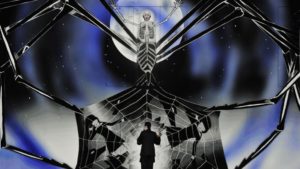
Deutsche Oper Am Rhein 2018-19 Review: The Magic Flute
Imaginative ‘1927’ Magic Flute Continues to Weave Magic into Mozart
By Santosh VenkataramanSince its premiere at the Komische Oper Berlin in 2012, the production of Mozart’s “The Magic Flute” by Barrie Kosky, Suzanne Andrade and Paul Barritt has enjoyed nothing short of a sensational journey throughout the world.
And while still not near a decade into its existence, it continues to be a vehicle for the potential of breathing life into opera with an absolutely imaginative staging of this classic work that was seen recently at the Oper Am Rhein in Düsseldorf.
The idea was conceived when Kosky met with Andrade and Barritt, who work for the British theater company 1927 – named after the year when Al Jolson’s “The Jazz Singer” created a sensation as the first motion picture “talkie” that helped herald the end of silent films.
That set the wheels in motion for this “Flute” as a silent film with several notable twists.
A Movie Screen Unlike Any Other
A silent movie is seemingly unfolding on a large screen, with animations and projections that are so creative and clever it is impossible to keep up with everything going on. The singers appear gradually on small platforms protruding out from the screen and interact with the graphics around them or they walk on stage and take part in the same fashion.
The former restricts their movements but requires more precision so that they fit in seamlessly with the animations, while the latter allows for more comic actions.
The screen also functions to display the spoken dialogue, which is thus taken off the singers’ plates. It adds to the myriad of possibilities for the animator Barritt and actually focuses the audience on the text in a different way than reading supertitles would.
The animated dialogue combined with magical creatures on screen and machinations of the singers create a visual feast that included beating hearts, skeletons, butterflies, birds and countless others.
This is a true fantasy world appropriate for “The Magic Flute,” with Pamina chased by an evil monster and the Queen of the Night depicted as a nefarious spider. It’s also an homage to the silent world, with Papageno analogous to Buster Keaton and Pamina to Louise Brooks.
Yet rather than just serve as a reminiscence of the past, this “Flute” dually conveys a vision of the future through the liveliness of the projections. This staging has another unwitting positive effect; it encourages repeat viewing to pick up aspects on screen that were missed the first time by audience members who are usually so enthralled by the visuals.
An Afterthought?
It seems odd to have to give short shrift to the musicians at an opera, and particularly for one of Mozart’s masterworks. Yet the inventiveness of this production forces the music to be somewhat of an afterthought, or at most a complementary part of the milieu.
None of that is to denigrate the music, with conductor Jochen Rieder and his Duisburg Philharmonic essentially forced to take a back seat to the work of the creative team. Rieder still deserves credit for ensuring the music would sync up with the singers’ actions under these unusual circumstances.
Often, it would be anathema in opera for a staging to take away from the singers. This is the exception to the rule, however. Because while their work is minimized, part of what these performers must do is impeccably blend in with and work with the surroundings.
The ensemble cast, many of which I had never heard sing before, was admirable.
Baritone Dmitri Vargin as Papageno and Lavinia Dames as Pamina were both white-faced as silent film stars and among the standouts.
Tenor Bernhard Berchtold’s Act one “Dies Bildnis” was beautifully sung and had an added humorous effect since his Tamino was actually falling in love with a picture! The soprano Antonina Vesenina – or at least her face – was the Queen of the Night seen on top of a spider’s body.
The overwhelming takeaway on all of these performers was mainly about how fascinating it was for them to follow exacting stage directions.
If much is debated these days about attracting audiences to opera, productions like the 1927 “Magic Flute” have to be the answer. Kosky, Andrade and Barritt have created an absolute gem that should enjoy a lengthy run as an audience favorite.
This is a production that is mesmerizing to seasoned operagoers and newcomers alike as well as the young and old, and it was a welcome sight to see so many children in the audience at this performance in Düsseldorf. It has been seen in the United States in Los Angeles, Minnesota and Cincinnati and should be sought after by more companies.


